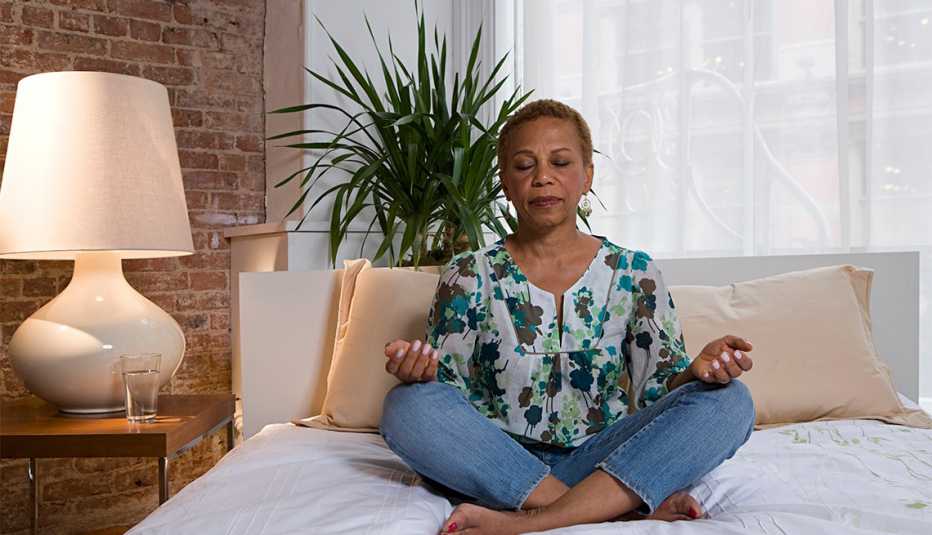Staying Fit


If you've always been interested in — if a bit daunted by — the idea of meditating, now might be the perfect time to forge ahead with the practice. Research shows that cutting through the mental static and focusing your mind this way helps alleviate stress and anxiety, slows aging, improves your attention span — and can even act as a sleep aid. Studies have found it can also help alleviate pain, control blood pressure and improve digestion. And who doesn't need help with all of the above?
That said, for something so simple (what's more straightforward than, say, concentrating on your own breath?), meditation can take effort. Sitting still, as is often involved, isn't necessarily as easy as it sounds. And try to focus on a singular phrase or idea can be tedious for minds used to wandering at will. And then there's the need to sort out what exactly, you're even trying to do.


AARP Membership— $12 for your first year when you sign up for Automatic Renewal
Get instant access to members-only products and hundreds of discounts, a free second membership, and a subscription to AARP the Magazine.
"People often think meditation is about getting rid of thoughts or feelings, which it's not,” says Sharon Salzberg, cofounder of the Insight Meditation Society, and author of Real Happiness: The Power of Meditation and Real Change: Mindfulness to Heal Ourselves and the World. “Or they think it's about having only beautiful thoughts or peaceful states, which it's also not. Meditation is about developing a different relationship with our thoughts."
Say, for instance, you've been taking in a steady stream of news. Your mind — no surprise — becomes fixed on all the many what-ifs, such as: What if life never returns to normal? Meditation, a form of mindfulness, allows you “to see what's happening right now without distorting it,” Salzberg says. “It's not that difficult things don't arise; they do. But we don't have to add to them. With mindfulness we learn to feel a whole range of emotions and physical sensations without getting swept up in them — or trying to push them away."
6 tips for getting started
The guided meditations that follow are designed to help with all of that. Before you begin, keep the following pointers in mind.
1. You don't have to meditate for hours.
Benefits appear pretty fast. In a study published in Psychoneuroendocrinology, participants who meditated just 25 minutes a day for three days reduced their levels of stress. That said, you will need to build up your own stamina. Aim for five minutes a day for two weeks and gradually work up to longer. Set the timer on your phone or follow a short meditation on an app.
2. When and where are up to you.
"Morning could be good because it sets the stage for the rest of your day,” Salzberg says. “Some people meditate at night because it helps them sleep better. Think about what's realistic for you. Back in the days when people were driving to work, someone told me they'd go to work early, then sit in the parking lot and meditate."
3. Choose something specific to focus on.
It can be your breath, a saying or “mantra” that you repeat, or something you can fix your gaze on. “If you're anxious, pay attention to your feet because your feet are an anxiety-free zone,” suggests Jud Brewer, M.D., director of research and innovation at the Brown University Mindfulness Center and associate professor of psychiatry at Brown's medical school. Next, Brewer instructs to ask yourself simple questions about what you're focusing on, such as “Which foot feels warmer … or tingly-er right now?” As he explains, it doesn't matter at all which foot feels what, but asking the questions “awakens our natural capacity to be curious, and curiosity is really key here."
4. There's no right or wrong way to meditate.
You don't have to perch pretzel-like on a cushion if that isn't comfortable. Try simply sitting with your legs and arms uncrossed, your arms resting on your legs and feet on the floor so that you feel grounded, advises Megan Jones Bell, chief science officer at Headspace, a digital health company that provides guided meditation training. “Remember, the goal is to feel relaxed, comfortable and focused.”
5. Your mind will wander.
And that's OK. “One of the biggest misconceptions of meditation is that it has to be done correctly 100 percent of the time,” Bell says. “The truth is, it just doesn't happen like that immediately. The idea of meditation is to sit and be comfortable with our mind as it is. Sometimes the mind is busy. Sometimes it's quiet. But over time, as we get better at this, the mind naturally starts to settle down.”
6. Mini meditations count, too.
Before you hit “send” on an email, take three deep breaths. When you get a phone call, let it ring three times — long enough for a deep breath — before picking it up. Or resolve to fully be in the moment when you do a simple, pleasurable ritual such as drinking a cup of tea. What does that mean, exactly? No watching TV or checking your email at the same time, for starters. The idea is to really focus on what you're doing, Salzberg says, “so you can smell the tea, taste the tea, feel the warmth of the teacup."




































































More on Health
8 Things to Do at 50+ to Help You Live Longer
It’s never too late to make small changes to improve your health
How to Create a Sleep Sanctuary and Other Tips for a Good Night's Sleep
13 habits to give your body the rest it needs
7 Ways Working Out is Great for Mental Health
Exercise boosts mood, reduces depression and eases anxiety